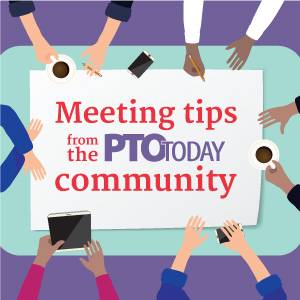PTO Leaders Share Ideas To Make Most of Meetings

If you’re a PTO leader, then you’ve struggled at some point with meetings—both getting people there and making them useful and fun. It goes with the territory. Luckily, we have a great community of parent group leaders who joined us last night on Facebook to ask questions and share tips about meetings. Here’s a summary of the Live Q&A session, and you can also view the chat on our Facebook page.
Let’s start with the basics: How do PTOs and PTAs get parents to come to meetings?
Send out a survey at the beginning of the year asking parents what would get them to meetings. Ask about time, day of week, meeting place, day care, and any changes they would recommend.
Try parent-led workshops at meetings. For example, an accountant can do a presentation on taxes or a medical professional could talk about germs and how to prevent spreading them.
Use name tags for everyone so people can socialize without feeling uncomfortable about forgetting someone’s name.
Offer snacks.
Keep meetings to an hour or less. Most parents simply don’t have more time than that.
Consider a little healthy competition. One community member says her group will be challenging teachers to help with attendance. The teacher with the most parents will get $50 to spend on classroom supplies.
Change up times and locations. A new location can make a meeting feel like a special occasion. One community member says her group held a few meetings at a local park. Parents met while kids played on the playground.
Try a meeting over a meal, like having lunch sent in or meeting at a restaurant.
Don’t be afraid to have a little fun at meetings: Try some icebreaker games. Do trivia questions about the school. Door prizes can work, too.
And how do groups get parents to come back?
It really helps to make sure you give newcomers a positive experience. Assign someone as a greeter so they don’t feel like an outsider and introduce everybody at the start of the meeting.
Don’t discuss things like a group of insiders using jargon that folks don’t understand. Take a few minutes to provide a little background on each project you discuss.
Try adding a social time afterward for folks who want to stay and get to know each other.
Remember that not all parents feel comfortable sharing at a meeting. Try keeping a suggestion box so parents can get a private or anonymous message to you.
Meetings aren’t just about PTO business anymore. Provide resources and information that help attendees with a variety of parenting and education issues.
If you don’t know what’s on parents minds, do a survey to find out.
Make presentations fun. For instance, if you have a nutritionist talk about healthy eating choices for kids, provide a few samples of healthy snacks that parents can try.
Try to find a topic that is compelling but not too controversial. Consider issues like Internet safety, bullying, and homework, but stay away from hot-button political issues.
Go with the flow: Meeting attendance changes over the years.
At the elementary level, you need to think about family dinnertime and bedtimes when planning. You might think about serving pizza or sandwiches. Then you’ve just solved the dilemma for parents of when to eat and what to eat for dinner.
For the elementary crowd, child care is key. Ask National Honor Society members from the local high school to watch the kids during meetings. (They need service hours.) Another option is having a few parents take turns with the child care.
When you move up to middle school, you will likely see an attendance drop-off. Don’t be alarmed. Put emphasis on guest speakers and providing resources about middle school issues like living with teenagers.
PTO meetings at the high school level are similar to middle school meetings in that you’ll want to be more of a resource to parents. In particular, provide experts who can address college-related topics. Even grade 9 parents will be interested.
Beyond meetings: Keeping the community connected.
More and more, we are moving beyond the traditional definition of meetings. It helps to accept that some parents are just not going to make it to meetings, but they do want to be involved.
Experiment with basic technologies like Skype and FaceTime to include parents who are at home or work.
Do a quick summary of a meeting and post it on Facebook. This is the official meeting minutes document, so it doesn’t have to be perfectly prepared. But it delivers meeting information quickly.
Keep the website updated with meeting information. Use Facebook and Twitter to direct parents there as soon as it’s posted.
Don’t forget email! It’s essential for communicating with your parents who don’t use social media. (Yes, they do exist!)
Remember, meetings don’t define the success of your group!
While it’s important to work on attendance and make your meetings as awesome as you can, no leader should feel bad if attendance stays low. If your group is active and has parent volunteers at its events, then you are a success. Meetings are a key part of your group, but they don’t define your group!






















